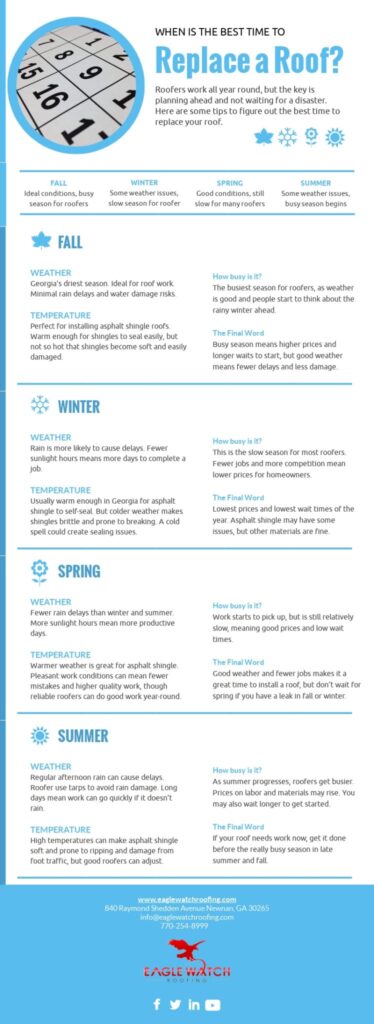When it comes to replacing your roof, timing is everything. You want to ensure that you choose the right time of year to get the job done, avoiding any weather-related setbacks or potential damage to your home. In this article, we will explore the different seasons and their impact on roof replacement, helping you make an informed decision that will protect your investment and provide peace of mind for years to come. So, let’s dive into the best time of year to replace a roof!

Factors to Consider
When deciding on the best time to replace a roof, there are several important factors to consider. These factors include climate conditions, the availability of contractors, cost considerations, and seasonal demands. By carefully evaluating each of these factors, you can make an informed decision that will ensure a successful roof replacement project.
Understanding the Climate
Before scheduling a roof replacement, it is crucial to understand the climate conditions in your area. Extreme weather conditions can greatly impact the installation process and the overall durability of the new roof. By taking into account the temperature and humidity levels, you can better plan for a smooth and efficient roof replacement project.
Extreme Weather Conditions
Certain regions are prone to extreme weather conditions, such as hurricanes or heavy snowstorms. These weather events can pose significant challenges during a roof replacement project. Strong winds, heavy rain, or snow can make it unsafe for contractors to work on the roof. Additionally, these weather conditions can cause delays and potential damage to the roofing materials. It is essential to choose a time of year when the risk of extreme weather is minimal to ensure a successful roof replacement.
Temperature and Humidity Levels
The temperature and humidity levels in your area also play a crucial role in the roof replacement process. Extreme temperatures, whether too hot or too cold, can affect the efficiency and effectiveness of the installation. Adhesive materials may not cure properly in extremely hot or cold weather, leading to potential problems with the roof’s integrity. Similarly, high humidity levels can prolong the drying time of certain materials, causing delays in the installation process. It is important to consider these climate factors to ensure optimal conditions for a roof replacement.
Availability of Contractors
Another important factor to consider when planning a roof replacement is the availability of contractors. Roofing contractors tend to have busy seasons and off-seasons, which can affect their schedule and availability for your project. Evaluating the availability of contractors can help you determine the best time of year to schedule your roof replacement.
Busy Season for Roofing Contractors
Roofing contractors often experience a peak season when demand for their services is high. This peak season usually occurs during the spring and summer months when homeowners are more likely to schedule roof replacements and repairs. During this time, contractors may have a full schedule and limited availability, making it challenging to secure their services promptly. If you plan to have your roof replaced during the contractor’s busy season, it is advisable to schedule well in advance to ensure their availability.
Off-Season Availability
On the other hand, the off-season for roofing contractors provides an opportunity for homeowners to schedule their roof replacements with greater flexibility. During the fall and winter months, when demand for roofing services decreases, contractors often have more availability. Scheduling a roof replacement during the off-season can result in shorter wait times for contractors and potentially even discounted rates. Consider the availability of contractors when determining the best time for your roof replacement project.
Cost Considerations
When it comes to roof replacement, cost is undoubtedly a significant factor to consider. The overall cost of a roof replacement project can be influenced by various factors, including the time of year. By understanding the cost considerations associated with each season, you can make an informed decision that aligns with your budget.
Off-Season Discounts
During the off-season, roofing contractors may offer discounts or special promotions to attract customers. Since demand is lower during this time, contractors may be more willing to negotiate pricing to secure projects. Taking advantage of off-season discounts can potentially save you money on your roof replacement project. It is important to inquire with multiple contractors to compare prices and ensure you are getting the best deal possible.
Material Prices
The cost of roofing materials can also fluctuate throughout the year. Prices may be higher during peak demand seasons when demand for materials is at its highest. By scheduling a roof replacement during a less-demanding season, you may be able to find more cost-effective materials without compromising quality. Consider researching and comparing material prices to make an informed decision that fits your budget.
Labor Costs
Labor costs can vary depending on the time of year. During peak demand seasons, when contractors are busier, labor costs may be higher due to increased competition for their services. Conversely, during the off-season, when contractors have more availability, you may have more negotiating power to secure more favorable labor rates. It is important to factor in labor costs when budgeting for your roof replacement to ensure you are financially prepared.

Seasonal Demands
Understanding the seasonal demands for roof replacements can help you select the best time of year for your project. By considering peak demand seasons and off-peak seasons, you can plan your roof replacement accordingly.
Peak Demand Seasons
Spring and summer are typically considered peak demand seasons for roof replacements. During these months, homeowners are more likely to schedule roof replacements and repairs, resulting in higher demand for contractors’ services. While scheduling during the peak season may provide more availability for materials and contractors, it is essential to consider the potential challenges, such as limited availability and higher costs.
Off-Peak Seasons
Fall and winter are generally considered off-peak seasons for roof replacements. During these months, the demand for roofing services decreases, which can lead to shorter wait times for contractors and potentially lower costs. Scheduling your roof replacement during the off-peak season may provide you with more flexibility and potentially even discounts on materials and labor. However, it is important to consider the effect of cold weather and limited contractor availability during this time.
Benefits of Replacing a Roof During Spring
Spring is often considered an ideal time to replace a roof due to several compelling reasons. The milder weather conditions, availability of contractors, and budget-friendly options make spring an attractive season for homeowners considering a roof replacement.
Milder Weather Conditions
Spring offers more favorable weather conditions compared to the extreme heat of summer or the bitter cold of winter. Mild temperatures and lower humidity levels create optimal conditions for the installation process. Roofing materials, such as adhesives and sealants, can cure more effectively in the moderate spring weather, ensuring the longevity and durability of the new roof.
Availability of Contractors
Spring is a busy season for roofing contractors, but it also brings greater availability compared to the peak summer months. By scheduling your roof replacement in the spring, you can secure the services of reputable contractors without the need for extended waiting periods. This means that your project can be completed promptly, allowing you to enjoy the benefits of your new roof sooner.
Budget-friendly Options
While spring is a popular time for roof replacements, it is also a season when contractors may offer attractive discounts or promotions. Taking advantage of these budget-friendly options can help you save on your roof replacement project. By combining the availability of contractors and potential off-season discounts, replacing your roof in the spring can be a cost-effective decision.

Choosing Summer for Roof Replacement
Summer may offer longer days and optimal working conditions, but there are several factors to consider before choosing this season for your roof replacement project.
Longer Days and Optimal Working Conditions
One of the advantages of choosing summer for a roof replacement is the longer daylight hours. Contractors have more time to work on the project each day, potentially speeding up the installation process. Additionally, the warmer weather allows roofing materials to bond and cure more efficiently. The optimal working conditions provided by summer can result in a smoother and quicker roof replacement.
High Demand and Lack of Availability
One significant challenge of scheduling a roof replacement during the summer is the high demand for roofing services. Many homeowners choose this time of year for their projects, which can lead to limited availability for contractors. It is important to schedule well in advance to secure the services of reputable contractors promptly. Failure to plan ahead may result in longer wait times and delays in completing your roof replacement.
Higher Costs
The high demand for roofing services in the summer can also lead to increased costs. Contractors may charge premium rates due to the competitive nature of the market during this season. Additionally, material prices might be higher due to the increased demand. It is crucial to consider these potential higher costs when budgeting for your roof replacement project.
Fall as an Ideal Season
Fall offers several advantages as an ideal season for roof replacement. The moderate weather conditions, contractor availability, and end-of-year discounts make it an appealing choice for homeowners considering a roof replacement.
Moderate Weather
Fall generally offers mild and moderate weather conditions, making it a favorable time for roof replacements. The moderate temperatures and lower humidity levels provide optimal working conditions for both contractors and roofing materials. The pleasant weather allows for efficient installation and ensures the quality and durability of your new roof.
Contractor Availability
During the fall, the demand for roofing services generally decreases compared to the peak summer months. Contractors often have more availability and shorter wait times during this season. Their reduced workload means that your roof replacement project can be completed promptly. As contractors have more flexibility in their schedules, they may also be more receptive to negotiating pricing.
End-of-Year Discounts
The fall season brings the added advantage of end-of-year discounts on both labor and materials. Contractors may offer special promotions to attract customers before the winter season. Additionally, suppliers may reduce prices on roofing materials to clear out inventory before the end of the year. Taking advantage of these end-of-year discounts can result in cost savings on your roof replacement project.

Winter Considerations
While winter is generally not considered an ideal season for roof replacements, it is still possible to have a successful project with careful planning. However, several challenges and considerations make winter a less favorable choice for most homeowners.
Challenges of Cold Weather
Cold weather presents numerous challenges during a roof replacement project. Low temperatures can affect the installation process and the performance of adhesives and sealants. The curing process may slow down significantly, potentially leading to longer project timelines. In areas with heavy snowfall, the accumulation of snow on the roof can pose safety risks for contractors and potentially damage the roofing materials. It is crucial to carefully assess the impact of cold weather on the installation process before scheduling a roof replacement in winter.
Limited Contractor Availability
Winter is generally a slow season for roofing contractors, resulting in limited availability. Many contractors reduce their workload during this season or may take vacations. It may be challenging to secure the services of reputable contractors promptly. However, if you plan well in advance and are flexible with scheduling, it is still possible to find contractors who are willing to undertake your roof replacement project during the winter season.
Possible Material Issues
Certain roofing materials may be more susceptible to damage or installation issues in cold weather. For example, asphalt shingles may become brittle or more difficult to work with in freezing temperatures. It is essential to consult with professionals experienced in winter roof replacements to ensure the proper selection and installation of materials. By addressing potential material issues, you can mitigate risks and ensure the success of your roof replacement project.
Conclusion
In conclusion, choosing the best time to replace a roof requires careful consideration of various factors. Understanding the climate conditions, availability of contractors, cost considerations, and seasonal demands is essential to make an informed decision. While each season has its advantages and challenges, it is important to prioritize factors such as weather conditions, contractor availability, and budget constraints. By taking into account all these factors, homeowners can plan and schedule a successful roof replacement project that ensures durability, efficiency, and cost-effectiveness.
